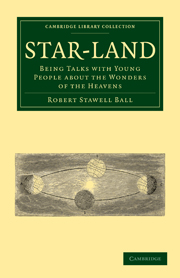LECTURE IV - THE GIANT PLANETS
Published online by Cambridge University Press: 01 June 2011
Summary
JUPITER, SATURN, URANUS, NEPTUNE
Our lecture to-day ought to make us take a very humble view of the size of our earth. Mercury, Venus, and Mars may be regarded as our peers, though we are slightly larger than Venus, and a good deal larger than Mercury or Mars; but all these four globes are utterly insignificant in comparison with the gigantic planets which lie in the outer parts of our system. These great bodies do not enjoy the benefits of the sun to the same extent that we are permitted to do; they are so far off that the sun's rays become greatly enfeebled before they can traverse the distance; but the gloom of their situation seems to matter but little, for it is highly improbable that these bodies could be inhabited. Though they get but little of the sun's heat, they seem to have ample heat of their own.
A view of parts of the paths of these four great planets is shown in Fig. 63. The innermost is Jupiter, which completes a circuit in about twelve years; then comes Saturn, revolving in an orbit so great that twenty-nine years and a half is required before the complete journey is finished. Still further outside is Uranus, which has a longer journey than Saturn, moves so much more slowly, that a man would have to live to the ripe old age of eighty-four if a complete revolution of Uranus was to be accomplished during his lifetime.
- Type
- Chapter
- Information
- Star-LandBeing Talks with Young People about the Wonders of the Heavens, pp. 198 - 237Publisher: Cambridge University PressPrint publication year: 2010First published in: 1889



